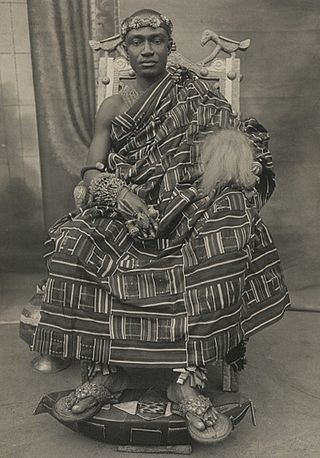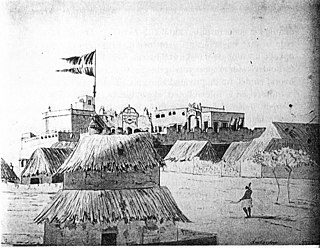Osei Kofi Tutu I was one of the founders of the Ashanti Empire, assisted by Okomfo Anokye, his chief priest and a distant relative from the town of Awukugua–Akuapem. The Asante comes from the Akan ethnic group of West Africa. Osei Tutu I led an alliance of Asante states against the regional hegemony, the Denkyira, completely defeating them. He ruled the Kwaman State between c.1680/c.1695 and 1701 and he ruled the Ashanti Empire from late 1701 to around 1717.

Osei Tutu II is the 16th Asantehene, enstooled on 26 April 1999. By name, Otumfuo Osei Tutu II is in direct succession to the 17th-century founder of the Ashanti Empire, Otumfuo Osei Tutu I. He is also the Chancellor of the Kwame Nkrumah University of Science and Technology. A Freemason, Otumfuo Osei Tutu II has served as the Grand Patron of the Grand Lodge of Ghana, the Sword Bearer of the United Grand Lodge of England and the Grand Patron of the Grand Lodge of Liberia.
The Akan people are a Kwa group living primarily in present-day Ghana and in parts of Ivory Coast and Togo in West Africa. The Akan speak dialects within the Central Tano branch of the Potou–Tano subfamily of the Niger–Congo family. Subgroups of the Akan people include: the Agona, Akuapem, Akwamu, Akyem, Anyi, Ashanti, Baoulé, Bono, Chakosi, Fante, Kwahu, Sefwi, Wassa, Ahanta, and Nzema, among others. The Akan subgroups all have cultural attributes in common; most notably the tracing of royal matrilineal descent in the inheritance of property, and for succession to high political office. All Akans are considered royals in status, but not all are in royal succession or hold titles.
Okomfo Anokye was the first priest (Okomfo) of the Ashanti Empire. Anokye is known for his participation in the expansion of the empire. He was also the codifier of the constitution and laws of the Ashanti Empire.
Asamankese is a town in south Ghana and is the capital of West Akim Municipal District, a district in the Eastern Region of south Ghana. Asamankese has a 2013 settlement population of approximately 39,435 people. Asamankese is on the main highway to Kumasi and Accra in the interior. The people of Asamankese celebrate the Obuodwan festival.

The Akyem are an Akan people. The term Akyem is used to describe a group of four states: Asante Akyem, Akyem Abuakwa, Akyem Kotoku, and Akyem Bosome. These nations are located primarily in the eastern region in south Ghana. The term is also used to describe the general area where the Akyem ethnic group clusters. The Akyem ethnic group make up between 3-4 percent of Ghana's population depending on how one defines the group and are very prominent in all aspects of Ghanaian life. The Akyem are a matrilineal people. The history of this ethnic group is that of brave warriors who managed to create a thriving often influential and relatively independent state within modern-day Ghana. When one talks of Ghanaian history, there is often mention of The Big Six. These were six individuals who played a big role in the independence of Ghana. Of the big six, people of Akyem descent made up the majority.
Akwamu was a state set up by the Akwamu people in present-day Ghana. After migrating from Bono state, the Akan founders of Akwamu settled in Twifo-Heman. The Akwamu led an expansionist empire in the 17th and 18th centuries. At the peak of their empire, Akwamu extended 400 kilometres (250 mi) along the coast from Ouidah, Benin in the East to Winneba, Ghana, in the West.
Agogo is a town in the Asante Akim North Municipal District of the Ashanti Region of Ghana. Agogo is approximately 80 kilometers (50 mi) east of Kumasi, the capital of the Ashanti Region, and had a population of 28,271 in the 2000 census. Computer projections estimate that the 2007 population was 32,859.

Otumfuo Opoku Ware II was the 15th Asantehene. He succeeded his uncle Osei Tutu Agyeman Prempeh II on 27 July 1970. He ruled for 29 years until his death in February 1999. He was succeeded by Otumfuo Nana Osei Tutu II.
In several Akan nations of Ghana, the Omanhene is the title of the supreme traditional ruler ('king') in a region or a larger town. The omanhene is the central figure and institution of the nation. Officially, he has no function in the current Ghanaian political setup, but, has enormous influence on the people that constitute it. Today 'Hene' can be found in titles of other rulers in Ghanaian nations. For example, the chief of the Dagomba in the north of Ghana is known as the 'Dagombahene'.
Aduana Football Club is a professional football club, based in Dormaa Ahenkro, Bono Region, Ghana. The club is competing in the Ghanaian Premier League. It made history by winning the Ghana Premier League at their first attempt with 53 points. It became the ninth club to win the Ghana Premier League in its 54-year-old history.
The Akuapem, is one of the few confederacies in Ghana.It consist of people of Guan and Akan decent.The Akuapem State has a total land area of 1519.13 square kilometres. They reside mostly to the south of the Eastern Region of Ghana. They are indigenous, consisting of both patriarchal Volta-Comoe-speaking Guans and matriarchal Kwa-speaking Akans.

Prempeh II, was the 14th Asantehene, or king of the Ashanti, reigning from 22 June 1931 to 27 May 1970.
Gã Mantse is the title of the Ghanaian chief of the Gã Traditional Area in the southern part of Ghana, where the Ga-Adangbe people dwell with Accra as the capital city. The Ga-Dangbe, Gã-Daŋbɛ, Ga-Dangme, or GaDangme are an ethnic group in Ghana, Togo and Benin. The current Ga Mantse is King Tackie Teiko Tsuru II known in private life as Dr Kelvin Nii Tackie Abia, a prosperous entrepreneur, who was duly sworn in by the Ga Paramount Stool Dzasetse Dr Nii Tetteh Kwei II, a host of Dzasefoi (Kingmakers) and other traditional leaders as per customary and traditional demands.
Nana Agyemang Badu I was a traditional ruler in Ghana and Paramount Chief of Dormaa Traditional Area in the Bono Region. His official title was Dormaahene - chief of Dormaa. He was the sixth president of the National House of Chiefs and served from 1978 to 1982. He was also the head of the Brong Ahafo regional House of Chiefs. He was the founding father of the Dormaa Secondary School also known as Dormas which is located in the heart of Dormaa Ahenkro Bono Region. Osagyefo was a close friend of the late Rtd.Ft. Lt.Jerry John Rawlings who was usually seen at the Kwafie Festival. In his private life, Osagyefo was a medical doctor.
Kwame Boahene Yeboah-Afari was an educator and a politician. He served in various ministerial portfolios of the first republic including serving as Ghana's first Minister for Agriculture and the first Regional Minister for the Brong Ahafo Region. He also served as a member of parliament for the Sunyani East constituency.
Stephen Willie Yeboah was a Ghanaian politician. He served as a regional commissioner for the Brong Ahafo Region, the Ashanti Region and the Western Region. He also served as a member of parliament for the Sunyani West constituency and later the Dormaa constituency.
Akwamufie Palace is the seat of the Akwamuhene of the Akwamu people, as well as his official residence. It is currently occupied by the current king of Akwamu state, Odeneho Kwafo Akoto III. Odeneho Kwafo Akoto III has been steering the affairs of the kingdom of Akwamu from the Bogyawe Palace since he ascended the throne in the year 2011. It is located at Akwamufie along the bank of the Volta river in the Eastern Region in Ghana. The palace has a museum and is also a traditional monument for tourist attraction. It is also known as the Bogyawe Palace.
Osagyefo OseadeeyoDr. Nana Freduah Agyemang Badu II is a Ghanaian traditional ruler who is the Omanhene of the Dormaa traditional area (Dormaaman) in Ghana. A grand durbar of chief, dignitaries, parliamentarians, government functionaries, ministers of state, Bonohene of Ivory Coast - Nana Agyeman Adinkrah II and distinguished citizens of Dormaa were present to outdoor Osagyefo, July 25, 1999. He is the President of the Bono Regional House of Chiefs.

The Assault on Osu was an assault on the coastal village of Osu Castle by the Kingdom of Akwamu against local Accrans, who received support from the Danes at Fort Christiansborg. The assault resulted in military failure for the Akwamu, mainly due to Danish artillery, and the Akwamu were forced to retreat.




